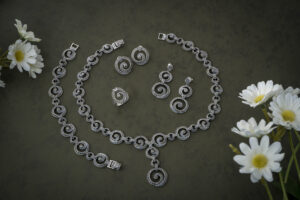Sterling silver has long been celebrated for its timeless beauty, versatile style, and luxurious shine. However, many people wonder why is sterling silver considered expensive, especially when it comes to handmade craftsmanship? The answer lies not only in the metal’s purity but also in the skill, artistry, and time required to create handcrafted jewelry that stands the test of time. 925
What Is Sterling Silver?

Sterling silver is an alloy made up of 92.5% pure silver and 7.5% copper or other strengthening metals. This combination ensures durability without sacrificing the soft, radiant shine that pure silver is known for. Authentic sterling silver is marked with the “925” hallmark, guaranteeing its purity and high quality.
Unlike mass-produced or plated jewelry, sterling silver retains its value because it is a genuine precious metal. It’s admired for its beauty, flexibility, and ability to enhance gemstones, making it an ideal choice for artisans and jewelers around the world.
Is Sterling Silver Expensive?
The question “Is Sterling Silver Expensive” often arises when comparing it with other metals such as stainless steel or brass. While it’s more affordable than gold or platinum, sterling silver jewelry especially handmade pieces can be more costly than mass-produced alternatives.
Here’s why sterling silver with handmade craftsmanship commands a higher price:
- High purity content: With 92.5% silver, it has real intrinsic value.
- Skilled craftsmanship: Each handmade piece is created by artisans who spend hours perfecting details.
- Durability: Properly crafted sterling silver can last a lifetime.
- Unique artistry: No two handmade pieces are identical, adding to their exclusivity.
- Emotional value: Handmade jewelry carries a story of dedication and creativity.
These factors make sterling silver jewelry not just a purchase but an investment in quality and artistry.
The Art of Handmade Craftsmanship
Handmade sterling silver jewelry is a true form of wearable art. Unlike machine-made pieces that rely on automation, handmade creations are shaped, soldered, engraved, and polished by skilled artisans. Every curve, line, and gemstone setting requires precision and patience.
This craftsmanship process involves multiple stages:
- Designing – Artisans conceptualize and sketch unique jewelry designs.
- Forming – Silver is melted, shaped, or hammered into desired forms.
- Detailing – Patterns, textures, and engravings are added by hand.
- Gemstone setting – Stones are precisely mounted for secure and beautiful presentation.
- Polishing – The final step enhances shine and ensures a flawless finish.
Each of these steps takes time, effort, and experience attributes that increase both the value and desirability of handmade sterling silver jewelry.
Why Handmade Jewelry Is More Valuable
While machine-made jewelry can be produced quickly and cheaply, handmade sterling silver pieces are crafted with care and attention to detail. This not only ensures superior quality but also gives each piece its own personality.
Key reasons handmade jewelry costs more:
- Time investment: Artisans dedicate hours or even days to perfecting one piece.
- Quality control: Every piece is individually inspected to meet high standards.
- Custom designs: Handmade jewelry often allows for personalization or bespoke orders.
- Limited production: Small-batch or one-of-a-kind items enhance rarity.
These qualities make handmade sterling silver jewelry a perfect balance between craftsmanship and value.
Sterling Silver vs. Mass-Produced Jewelry

When comparing handmade sterling silver with mass-produced alternatives, the differences become clear:
- Mass-produced jewelry uses molds and machinery, sacrificing uniqueness for speed.
- Handmade sterling silver prioritizes artistry, durability, and authenticity.
While machine-made jewelry may appear similar on the surface, handmade pieces carry superior construction and emotional resonance. Each piece tells a story of human creativity and skill.
The Role of Craftsmanship in Price
The artistry involved in crafting sterling silver pieces is one of the main reasons they are considered valuable. Jewelers use traditional techniques such as hand-soldering, filigree work, and detailed engraving that require years of practice to master.
Unlike automated production, handmade jewelry often incorporates design elements that reflect cultural heritage, artistic expression, or symbolic meaning. This combination of tangible and intangible value explains why handmade sterling silver pieces are more expensive than factory-made alternatives.
Longevity and Emotional Connection
Handmade sterling silver jewelry is built to last. When maintained properly, it can be passed down through generations, retaining both its beauty and emotional significance. Each piece becomes a reflection of personal milestones, memories, and artistic craftsmanship.
Moreover, buying handmade silver jewelry supports local artisans, preserving traditional jewelry-making skills and promoting sustainable production methods.
While sterling silver may not cost as much as gold or platinum, its handmade craftsmanship elevates it beyond mere material value. The combination of skilled artistry, attention to detail, and timeless design makes it both precious and enduring.
So, even though sterling silver is less expensive in comparison to gold, handmade pieces are prized for their authenticity, quality, and meaning. They remind us that true luxury lies not just in rarity but in the craftsmanship, dedication, and love poured into every creation.